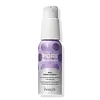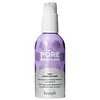What's inside
What's inside
 Key Ingredients
Key Ingredients

 Benefits
Benefits

 Concerns
Concerns

 Ingredients Side-by-side
Ingredients Side-by-side

Caprylic/Capric Triglyceride
MaskingSimmondsia Chinensis Seed Oil
EmollientPEG-40 Sorbitan Peroleate
EmulsifyingPersea Gratissima Oil
Skin ConditioningVitis Vinifera Seed Oil
Emollient1,2-Hexanediol
Skin ConditioningCaprylyl Glycol
EmollientParfum
MaskingBisabolol
MaskingPrunus Domestica Seed Oil
Skin ConditioningTriethyl Citrate
MaskingTocopherol
AntioxidantCeramide NP
Skin ConditioningTocopheryl Acetate
AntioxidantKaolin
AbrasiveSilica
AbrasiveGlycerin
HumectantButylene Glycol
HumectantPentylene Glycol
Skin ConditioningCI 77007
Cosmetic ColorantSodium Acrylates Copolymer
CI 77499
Cosmetic ColorantHydroxyacetophenone
AntioxidantLecithin
EmollientMica
Cosmetic ColorantChlorphenesin
AntimicrobialCI 77491
Cosmetic ColorantHydrogenated Vegetable Oil
EmollientOpuntia Coccinellifera Flower Extract
Skin ConditioningCI 77891
Cosmetic ColorantTrisodium Ethylenediamine Disuccinate
Disodium Phosphate
BufferingPotassium Hydroxide
BufferingXanthan Gum
EmulsifyingCrithmum Maritimum Extract
Skin ConditioningCI 77510
Cosmetic ColorantSodium Phosphate
BufferingSphingolipids
EmollientSphingomonas Ferment Extract
Skin ConditioningCitric Acid
BufferingPentaerythrityl Tetra-Di-T-Butyl Hydroxyhydrocinnamate
AntioxidantCoco-Betaine
CleansingPEG-120 Methyl Glucose Dioleate
EmulsifyingSodium Lauroyl Sarcosinate
CleansingMaltitol
HumectantSodium Methyl Cocoyl Taurate
CleansingSodium Cocoyl Isethionate
CleansingPolyacrylate Crosspolymer-6
Emulsion StabilisingSodium Benzoate
MaskingPolyquaternium-22
Isopropyl Alcohol
SolventSodium Citrate
BufferingCitrus Limon Fruit Extract
MaskingCitrus Junos Fruit Extract
Skin ConditioningCaprylic/Capric Triglyceride, Simmondsia Chinensis Seed Oil, PEG-40 Sorbitan Peroleate, Persea Gratissima Oil, Vitis Vinifera Seed Oil, 1,2-Hexanediol, Caprylyl Glycol, Parfum, Bisabolol, Prunus Domestica Seed Oil, Triethyl Citrate, Tocopherol, Ceramide NP, Tocopheryl Acetate, Kaolin, Silica, Glycerin, Butylene Glycol, Pentylene Glycol, CI 77007, Sodium Acrylates Copolymer, CI 77499, Hydroxyacetophenone, Lecithin, Mica, Chlorphenesin, CI 77491, Hydrogenated Vegetable Oil, Opuntia Coccinellifera Flower Extract, CI 77891, Trisodium Ethylenediamine Disuccinate, Disodium Phosphate, Potassium Hydroxide, Xanthan Gum, Crithmum Maritimum Extract, CI 77510, Sodium Phosphate, Sphingolipids, Sphingomonas Ferment Extract, Citric Acid, Pentaerythrityl Tetra-Di-T-Butyl Hydroxyhydrocinnamate, Coco-Betaine, PEG-120 Methyl Glucose Dioleate, Sodium Lauroyl Sarcosinate, Maltitol, Sodium Methyl Cocoyl Taurate, Sodium Cocoyl Isethionate, Polyacrylate Crosspolymer-6, Sodium Benzoate, Polyquaternium-22, Isopropyl Alcohol, Sodium Citrate, Citrus Limon Fruit Extract, Citrus Junos Fruit Extract
Caprylic/Capric Triglyceride
MaskingSimmondsia Chinensis Seed Oil
EmollientPEG-40 Sorbitan Peroleate
EmulsifyingPersea Gratissima Oil
Skin ConditioningVitis Vinifera Seed Oil
Emollient1,2-Hexanediol
Skin ConditioningCaprylyl Glycol
EmollientParfum
MaskingBisabolol
MaskingPrunus Domestica Seed Oil
Skin ConditioningTriethyl Citrate
MaskingTocopherol
AntioxidantCeramide NP
Skin ConditioningTocopheryl Acetate
AntioxidantPentaerythrityl Tetra-Di-T-Butyl Hydroxyhydrocinnamate
AntioxidantCaprylic/Capric Triglyceride, Simmondsia Chinensis Seed Oil, PEG-40 Sorbitan Peroleate, Persea Gratissima Oil, Vitis Vinifera Seed Oil, 1,2-Hexanediol, Caprylyl Glycol, Parfum, Bisabolol, Prunus Domestica Seed Oil, Triethyl Citrate, Tocopherol, Ceramide NP, Tocopheryl Acetate, Pentaerythrityl Tetra-Di-T-Butyl Hydroxyhydrocinnamate
Ingredients Explained
These ingredients are found in both products.
Ingredients higher up in an ingredient list are typically present in a larger amount.
1,2-Hexanediol is a synthetic liquid and another multi-functional powerhouse.
It is a:
- Humectant, drawing moisture into the skin
- Emollient, helping to soften skin
- Solvent, dispersing and stabilizing formulas
- Preservative booster, enhancing the antimicrobial activity of other preservatives
Bisabolol is famous for its skin soothing properties. It does this by blocking inflammatory signals, helping to reduce your body's reaction to irritation.
This ingredient also interferes with the process of hyperpigmentation. This can help with reducing dark spots and uneven tone.
Bisabolol is an antioxidant. Antioxidants help fight free-radicals. Free-radicals are molecules that may damage your skin cells. By fighting these free-radicals, Bisabolol may slow down signs of aging.
Studies have shown Bisabolol to have antimicrobial properties and may be a fungicide. These properties help preserve a product's shelf life.
All these properties makes bisabolol a great skin barrier helper ingredient.
Bisabolol also helps the absorption of other ingredients.
Note: Synthetic Bisabolol has been shown to be less effective.
Learn more about BisabololThis ingredient is an emollient, solvent, and texture enhancer. It is considered a skin-softener by helping the skin prevent moisture loss.
It helps thicken a product's formula and makes it easier to spread by dissolving clumping compounds.
Caprylic Triglyceride is made by combining glycerin with coconut oil, forming a clear liquid.
While there is an assumption Caprylic Triglyceride can clog pores due to it being derived from coconut oil, there is no research supporting this.
Learn more about Caprylic/Capric TriglycerideCaprylyl Glycol is a humectant and emollient, meaning it attracts and preserves moisture.
It is a common ingredient in many products, especially those designed to hydrate skin. The primary benefits are retaining moisture, skin softening, and promoting a healthy skin barrier.
Though Caprylyl Glycol is an alcohol derived from fatty acids, it is not the kind that can dry out skin.
This ingredient is also used as a preservative to extend the life of products. It has slight antimicrobial properties.
Learn more about Caprylyl GlycolCeramide NP is a type of ceramide and formally known as ceramide 3.
Ceramides are intercellular lipids naturally found in our skin that bonds dead skin cells together to create a barrier. They are known for their ability to hold water and thus are a great ingredient for dry skin.
Ceramides are an important building block for our skin barrier. A stronger barrier helps the skin look more firm and hydrated. By bolstering the skin ceramides act as a barrier against irritating ingredients. This can help with inflammation as well.
If you would like to eat ceramides, sweet potatoes contain a small amount.
Read more about other common types of ceramides here:
Ceramide AP
Ceramide EOP
Parfum is a catch-all term for an ingredient or more that is used to give a scent to products.
Also called "fragrance", this ingredient can be a blend of hundreds of chemicals or plant oils. This means every product with "fragrance" or "parfum" in the ingredients list is a different mixture.
For instance, Habanolide is a proprietary trade name for a specific aroma chemical. When used as a fragrance ingredient in cosmetics, most aroma chemicals fall under the broad labeling category of “FRAGRANCE” or “PARFUM” according to EU and US regulations.
The term 'parfum' or 'fragrance' is not regulated in many countries. In many cases, it is up to the brand to define this term.
For instance, many brands choose to label themselves as "fragrance-free" because they are not using synthetic fragrances. However, their products may still contain ingredients such as essential oils that are considered a fragrance by INCI standards.
One example is Calendula flower extract. Calendula is an essential oil that still imparts a scent or 'fragrance'.
Depending on the blend, the ingredients in the mixture can cause allergies and sensitivities on the skin. Some ingredients that are known EU allergens include linalool and citronellol.
Parfum can also be used to mask or cover an unpleasant scent.
The bottom line is: not all fragrances/parfum/ingredients are created equally. If you are worried about fragrances, we recommend taking a closer look at an ingredient. And of course, we always recommend speaking with a professional.
Learn more about ParfumPEG-40 Sorbitan Peroleate isn't fungal acne safe.
Pentaerythrityl Tetra-Di-T-Butyl Hydroxyhydrocinnamate (long name, huh?) is a synthetic antioxidant.
It is used to help stabilize other antioxidants or prevent the color from changing in a product.
As an antioxidant, it helps fight free-radical molecules. Free-radical molecules are capable of damaging our cells and other genetic material. Thus, antioxidants may reduce the signs of aging.
This ingredient is oil-soluble.
Learn more about Pentaerythrityl Tetra-Di-T-Butyl HydroxyhydrocinnamatePersea Gratissima Oil is also known as avocado oil.
Avocado Oil has antioxidant properties. It is mostly made up of the glycerides of fatty acids. About 67% of these fatty acids is made up of oleic acid. Palmitic acid and linoleic acid are also present.
These fatty acids help hydrate and soften the skin. It may increase collagen content in the skin. Collagen helps keep your skin plump and firm. This ingredient helps reduce inflammation and has not shown to clog pores.
This ingredient may not be fungal-acne safe due to its high fatty acid content.
Avocados also have B vitamins, vitamin K, vitamin C, vitamin E, and potassium.
Learn more about Persea Gratissima OilPrunus Domestica Seed Oil is an oil and isn't fungal acne safe.
This oil comes from the seeds of the desert shrub called Jojoba. It is more commonly known as jojoba oil, a non-comedogenic oil.
Jojoba oil does not contain fragrance and has many fatty-acids, making it a great soothing ingredient.
It also contains Vitamin E, a great moisturizing ingredient. Vitamin E is also an antioxidant and protects your skin against oxidative damage.
This ingredient humectant properties, meaning it helps draw moisture from the air. This helps keep your skin hydrated.
While jojoba has antibacterial properties, it is only able to kill some strains of bacteria.
Studies also show it helps in wound healing. In fact, Indigenous cultures have used jojoba as a moisturizer and to help treat burns for centuries.
Fun fact: Jojoba oil similar to natural human skin sebum, so it has a great effect on dry skin. It is also promising with helping to regulate sebum production.
Due to its fatty acid content, Jojoba oil may not be fungal acne safe. We recommend speaking with a professional if you have any concerns.
Learn more about Simmondsia Chinensis Seed OilTocopherol (also known as Vitamin E) is a common antioxidant used to help protect the skin from free-radicals and strengthen the skin barrier. It's also fat soluble - this means our skin is great at absorbing it.
Vitamin E also helps keep your natural skin lipids healthy. Your lipid skin barrier naturally consists of lipids, ceramides, and fatty acids. Vitamin E offers extra protection for your skin’s lipid barrier, keeping your skin healthy and nourished.
Another benefit is a bit of UV protection. Vitamin E helps reduce the damage caused by UVB rays. (It should not replace your sunscreen). Combining it with Vitamin C can decrease sunburned cells and hyperpigmentation after UV exposure.
You might have noticed Vitamin E + C often paired together. This is because it is great at stabilizing Vitamin C. Using the two together helps increase the effectiveness of both ingredients.
There are often claims that Vitamin E can reduce/prevent scarring, but these claims haven't been confirmed by scientific research.
Learn more about TocopherolTocopheryl Acetate is AKA Vitamin E. It is an antioxidant and protects your skin from free radicals. Free radicals damage the skin by breaking down collagen.
One study found using Tocopheryl Acetate with Vitamin C decreased the number of sunburned cells.
Tocopheryl Acetate is commonly found in both skincare and dietary supplements.
Learn more about Tocopheryl AcetateTriethyl Citrate comes from citric acid. It has masking, perfuming, and solvent properties. As a solvent, this ingredient helps disperse ingredients evenly in skincare.
One manufacturer claims this ingredient can:
According to perfume manufacturers, this ingredient is almost odorless but has a mild fruity, wine and plum scent. It can be used to mask the scent of other ingredients.
This ingredient can be plant-sourced or synthetic; it can naturally be found in cabbage and white wine.
Learn more about Triethyl CitrateVitis Vinifera Seed Oil comes from the grape vine. Grape seeds are a byproduct of creating grape juice or wine.
The components of grape seeds have many skin benefits. Research has found it to be antimicrobial and anti-inflammatory. It also contains many potent antioxidants such as Vitamin E , Vitamin C, proanthocyanidins, polyphenols, flavonoids, and anthocyanins. Proanthocyanidin has been shown to help even out skin tone.
Antioxidants help fight free-radical molecules. Free-radical molecules are capable of damaging our cells and other genetic material. Antioxidants help stabilize free-radicals by donating extra electrons. Grape seed extract may help reduce the signs of aging.
The antimicrobial properties of grape seed may help treat acne. However, more research is needed to support this claim.
Grape seed has also been found to help absorb UV rays. Grape seed extract should not replace your sunscreen.
The fatty acids of grape seed oil give it emollient properties. Emollients help soothe and soften your skin by creating a film. This film traps moisture within, keeping your skin hydrated.
Learn more about Vitis Vinifera Seed Oil